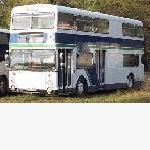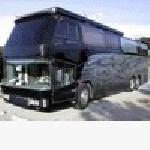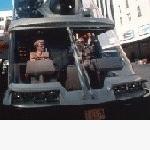| Author | Message | ||
| Bruce Henderson (Oonrahnjay)
Registered Member Username: Oonrahnjay Post Number: 610 Registered: 8-2004 Posted From: 70.60.102.61  Rating: N/A |
OK, a little basic question here. If you have a 24V system, you can "pull" 12V off that by using either a "converter" or an "equilizer", right? And if you need 200 watts of 12V, you need a 200 watt converter but if you need 400 watts, you'd need a 400 watt converter with the 400 watter costing more? Does the same thing apply to an "equalizer"; i.e. the more watts you need, the larger capacity (and therefore more money it costs) you have to buy? Thanks, all this is new to me so basic education is welcomed. | ||
| Derrick Thomas (Thomasinnv)
Registered Member Username: Thomasinnv Post Number: 1 Registered: 10-2010 Posted From: 69.19.14.29 Rating: N/A |
equalizers, like the vanner for instance, are rated in amps. The more amps you need the more you will pay for a vanner/equalizer. 200 watts @ 12v would be just under 17 amps. 400 watts = 33.3 amps. a 50 amp vanner would be good. I have a 50 amp vanner that I am going to install to charge the house batteries while under way. | ||
| George M. Todd (George_todd)
Registered Member Username: George_todd Post Number: 1128 Registered: 8-2006 Posted From: 99.180.11.80 Rating: N/A |
Bruce, Converter usually refers to changing 120 VAC to 12 VDC, and they usually have a battery charging circuit in them also. Equalizer usually is the term used to change DC Voltage. If I had a 200 Watt load, I would buy at least a 300 Watt equalizer, so it would last, rather than running one at 100% of its rating continuously. Derrick is correct in what he says, Watts are calculated by multiplying Amps times Volts. However, neither equalizers, nor inverters are 100% efficient, so a 200 Watt load will draw MORE than 17 Amps at 12 Volts, or 8 1/2 Amps at 24 Volts. G (Message edited by George_todd on November 03, 2010) | ||
| Bruce Henderson (Oonrahnjay)
Registered Member Username: Oonrahnjay Post Number: 611 Registered: 8-2004 Posted From: 70.60.102.61  Rating: N/A |
Dawggoneit, isn't there a free lunch anywhere????? | ||
| Ralph Peters (Ralph7)
Registered Member Username: Ralph7 Post Number: 157 Registered: 3-2004 Posted From: 75.195.84.57 Rating: N/A |
Juat add a one wire 10SI (GM) 12V., 60amp alt. Coast about $60.00 no core needed. Eastwood had a chrome plated one as a special for the car show, no I do not work for anyone, also the same alt. is built as 6V., 12V. 24V. and most 50 or 60amp, from $60.00-$99.00 pluss shipping. | ||
| Patrick levenson (Zubzub)
Registered Member Username: Zubzub Post Number: 261 Registered: 5-2007 Posted From: 174.93.213.103  Rating: N/A |
I really don't know what I am talking about here, but....If you only need 200 watts wouldn't it just be easier to just tap off one of your batts? The equalizers (as far as i understand them) are to help keep the batteries balanced and charged properly, but to my thinking a 200 watt load is fairly minor (especially if it is only intermittent). Anyhow i am the wrong person for this as all the intricacies of 12/24/battery systems are perhaps my weakest area, just adding my 2 cents in the interest of suggesting a simple (possibly incorrect) solution. | ||
| Bruce Henderson (Oonrahnjay)
Registered Member Username: Oonrahnjay Post Number: 612 Registered: 8-2004 Posted From: 70.60.102.61  Rating: N/A |
@ Ralph -- that's what I've done, actually, but I'm thinking of removing that and just using the stock alternator (or going to two separate alternators, both 24V for redundancy). It just seems inefficient to have the cabling necessary to run an inverter off 12V; also, cabling for the entire system would be lighter and simpler with 24V, if it was practical to have a supply of 12V for the things that just MUST be 12V. It's one of those "which bag is fuller" questions, I guess. @ Patrick - Yeah, I haven't calculated my exact wattage requirements (I think, pretty limited) but those numbers were just an example for discussion's sake. I'm just kinda baffled by all this and the idea of 12V, 24V and 120V all mixed together is the most baffling of all. | ||
| Patrick levenson (Zubzub)
Registered Member Username: Zubzub Post Number: 262 Registered: 5-2007 Posted From: 174.93.213.103  Rating: N/A |
Sean and co., are the ones who get this stuff, if you look at their sites it starts to make sense. My philosophy is to keep it really simple, so unless I had to have 24V I wouldn't. Sure a little heavy wire here and there, but really a main + lead to the front and then it's all the usual.... Anyhow best thing to do is research a little, I have yet to set up my house systems in any but the most simple way, seems like the complex systems are all about having all the switching automatic, between AC/DC shore power generator etc... | ||
| Bruce Henderson (Oonrahnjay)
Registered Member Username: Oonrahnjay Post Number: 613 Registered: 8-2004 Posted From: 70.60.102.61  Rating: N/A |
Yes, Patrick. I've been thinking on the same lines but it also seems that the "most simple" solution here is a "core" of 24V (that's my "start" system and that can't be changed) with branches to 120 and 12V. But maybe it's not. That's my real bottom- line quandry. | ||
| Bruce Henderson (Oonrahnjay)
Registered Member Username: Oonrahnjay Post Number: 614 Registered: 8-2004 Posted From: 70.60.102.61  Rating: N/A |
George, thanks for that info. In the aircraft world, a "converter" is mostly so that you can use a 12V avionics component in a 24V aircraft. As with most aviation stuff, they're breathtakingly expensive. | ||
| larry currier (Larryc)
Registered Member Username: Larryc Post Number: 335 Registered: 2-2007 Posted From: 207.200.116.13 Rating: N/A |
I have a 60 amp circuit in the truck shop that has about a 5000 watt load on it at times. Are you guys sure that you didn't leave a zero off somewhere? | ||
| Bruce Henderson (Oonrahnjay)
Registered Member Username: Oonrahnjay Post Number: 615 Registered: 8-2004 Posted From: 70.60.102.61  Rating: N/A |
Larry, A friend of mine named Georg Sean Todd Ohm says that 5000 Watts would be more than 400 amps at 12V. There are lots of zeros left off around here. (Seriously, big loads like air conditioning and the microwave will necessarily be 120V. My need for 12V won't go beyond some interior lamps, the "marine" 12V refrigerator, perhaps a circulator pump for heated coolant for heater cores, the "Aqua-Hot", the control circuit for the water heater, etc. It is time for me to figure these loads in detail, but we're not talking many thousands of watts of 12V - at least not in my case. Other converters' mileage may vary.) | ||
| Ralph Peters (Ralph7)
Registered Member Username: Ralph7 Post Number: 158 Registered: 3-2004 Posted From: 75.195.116.20 Rating: N/A |
When I replaced my engine, the 24V. alt. needed some work, also I did not change the rear gear houseing on the engine so no drive for alt. But all my exterior an interior lights are 12V.. I cut the buss bar in the bus distribtuion pannel and pulled in a #2 feed wire. I do not have 120 lights, just 12V. I built bus for 30amp., one 13,500 does a good job. No I wanted simple and 12V house and small 2000watt inverter/charger simple, had to keep 24V. for starting an engine fonctions. What do you want do in yuor coach, what appliances, stove , frig, heating, computers, etc, make a list. | ||
| George M. Todd (George_todd)
Registered Member Username: George_todd Post Number: 1129 Registered: 8-2006 Posted From: 99.180.11.80 Rating: N/A |
Larry, You're right about having a 5000 Watt load on a 60 Amp circuit! As it is 60 Amps, it is also 208, or 240 Volt, depending upon whether or not you have 3 phase power in your shop, and whether the transformers feeding you are Wye or Delta connected. If you have single phase, your voltage is 120/240, and the current load on 240 Volts, is 20.8 Amps. On 208 Volts, the amperage would increase to 24. 5000 Watts at 12 Volts would require just over 416 Amps. Wattage is easily calculated, it is just the Amps times the Volts. "Stealing" 12 Volt power from the grounded battery of a series pair works. It is also VERY HARD on the other battery in the pair, because the current required to recharge the discharged battery has to flow thru the fully charged battery to get to the discharged one. This causes the charged battery to be over-charged, which boils water out of it, and warps plates, causing premature failure. Just adding a 12 Volt 1-wire alt isn't quite that cheap, what about batterie(s) and cabling? G | ||
| Sean Welsh (Sean)
Registered Member Username: Sean Post Number: 1205 Registered: 1-2003 Posted From: 67.142.130.11  Rating: N/A |
Sorry I am late to the party here, but I have been out of the country for the last week. Bruce, your 200-watt load will require about 17 amps at 12 volts, and a 400-watt load will require twice that or just over 33 amps. However, the way equalizers work when properly wired, that current is being supplied by the "lower half" of the battery bank, and the equalizer then makes up for it over time. So the real question is how often and for how long is your 200-watt or 400-watt load present? A better way to think of this is that a 20-amp equalizer can supply 480 amp-hours of 12-volt power per day. A 30-watt unit can supply 720 amp-hours, and a 60-watt unit can supply 1,440 amp-hours. A 200-watt load uses about 17 amp-hours in an hour, and a 400-watt load uses about 33 amp-hours in an hour. Add up all the amp-hours of expected use on an average day, not just the maximum total wattage, to size your equalizer. Take the expected amp-hours of use per day and divide by 24 to get the size of equalizer you need. Most conversions can get by with a 20-amp equalizer. -Sean http://OurOdyssey.BlogSpot.com | ||
| john w. roan (Chessie4905)
Registered Member Username: Chessie4905 Post Number: 1992 Registered: 10-2003 Posted From: 71.58.71.157  Rating: N/A |
Since this subject came up and I'm replacing batteries, and have an equalizer, which I know little about it on this, new to me coach, I went to the Vanner site and read some info on their equalizers. Great info in their product manuals and the manuals explain how the units work, how to parallel for more output and how it maintains the batteries while drawing 12 volt from 24 volt system.Also some important cautions about disconnecting, etc. Worth the time to read. |